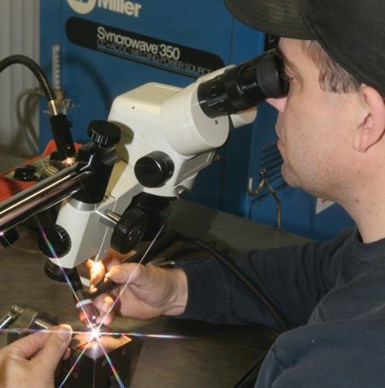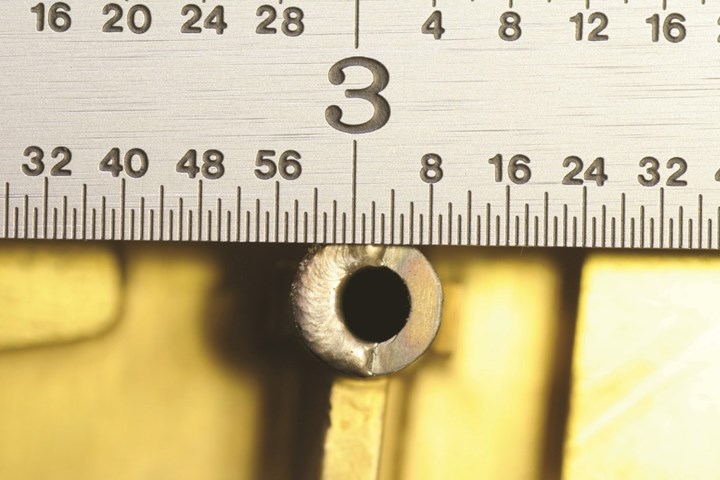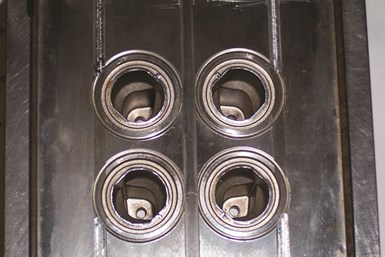
The micro welding process by FiveStar Toolwelding of Butler, Wisconsin. Photo Credit: Miller Electric Mfg
For as long as there have been molds, there has been the need for tool welding. This is to repair or restore components for molds, as well as restore surfaces machined or worn out of specification. The exact reasons for using the welding process is to eliminate fabrication of a new part or parts affected by engineering changes, wear, water leaks, damage from equipment malfunction or even an occasional metallurgical defect. Welding is also the option most often used to reduce cost and reduce lost time when compared to making new mold components.
Micro Welding
Micro welding is the name given to the process that has evolved from traditional TIG welding (or more recently termed GTAW), using the technology of electric current being applied to the workpiece to generate heat at the point of the arc gap. At the point of the arc gap, a molten pool is established and the filler rod is introduced into the molten pool.
Featured Content
The difference between traditional TIG and micro welding is that micro welding is done at extremely low amperages (usually less than 10 amps) in combination with fine control of the amperage range, along with the aid of a high-powered (10-20 times or more) microscope. In the micro welding process, the technician performing the weld repair — in combination with the welding equipment controls and the weld wire selection — is absolutely critical to end results.
Laser Welding
Laser welding — on the other hand — uses light energy to rapidly heat the weld zone, melting the filler rod along with the adjacent point of metal joining. The light energy intensity is controlled by beam size, voltage and pulse width, singularly or repeated at variably timed intervals. Because an independent high intensity light source is used, no current flows through the workpiece. There are no electrical connections or current polarity effects to the weld or to the workpiece with laser welding.
With the laser process, there is no heat generated in the workpiece by electrical current flow or resistance to flow. Because the laser beam is used to melt the base material and the filler rod, the process becomes a line of sight as well as focal point limited process. This means if you cannot get a straight shot with the laser beam to the weld zone or cannot position the weld zone at the correct focal point of the laser power, the process will not work efficiently or correctly. Microscopic magnification, similar to micro welding, also is used in the laser welding process.
Filler Rod Choices
Filler rod, or more appropriately termed wire, is small for both laser and micro welding. Wire sizes on the small side begin at .003 inch ranging up to .025 inch, usually in increments of .002 or .005 as the diameter increases over .015 inch.
Filler wire is available in most common tool steel and mold steel equivalents. There are copper alloys available for application on both copper nickel and beryllium copper alloys in the small sizes of filler wire, and of course, aluminum wire is available too.
In choosing a wire to use on tool steel, stainless grades of wire seem to show the most overwhelming success and compatibility. When applying a tool steel wire to a tool steel base, there can be the occasional issue relating to adhesion and contamination when using either the laser or micro weld process.
Other Notable Differences
At this time, laser welding equipment is extremely expensive when compared to micro welding equipment. Also, welding technicians experienced with the TIG process can have difficulty adapting to the difference in how the filler wire is used in the laser welding process.
Generally in laser welding, the filler wire is melted onto the workpiece with the heat of the light beam where the wire and workpiece are melted simultaneously. In the TIG process, the filler wire is melted by the introduction of the wire to the molten pool created by the arc gap.
Shielding gases are common to both laser and micro welding processes, although shielding gases are less critical in laser welding. Small repairs using the laser process with aluminum have shown superior results when compared to TIG. Most notable with laser welding is that the overall temperature of the workpiece rarely gets warmer than what can be held in your bare hand.
Summary
Both the laser and micro weld processes have positive and negative issues. Promoters of the laser welding process claim that dimensional and shape distortion are nonexistent with the laser process, yet during usage of the laser process, there has been an occasional change to both dimension and shape, which at each occurrence was unexpected. All appeared as cases that were completely unpredictable.
On the other hand, micro welding repairs — although not the rule — can still exhibit sink areas, fractures, separation of weld and other incidents occasional to the TIG welding process.
One thing is certain: both laser and micro welding processes are improvements to traditional TIG tool welding, and both processes have definite benefits and expanded opportunities for applications. The tool welding shop of the not too distant future will need to offer conventional TIG, micro welding and laser welding services to completely fulfill the tool welding requirements of its customers.
RELATED CONTENT
-
How to Eliminate Streaks and Weld Problems with Laser Technology
Laser technology overcomes streaking and welding challenges for new mold textures and texture repair.
-
PTXPO Preview 2023: Mold Material/Mold Base Needs
At PTXPO 2023, the Moldmaking Pavilion returns, housing exhibitors ready to meet attendees' mold material and mold base challenges head on.
-
Technologies for Maintaining, Repairing and Surface Treating Your Molds
This technology roundup covers everything from laser repair and mold protection coatings to in-house maintenance services and education tools for learning best practices behind taking care of injection molds.


















